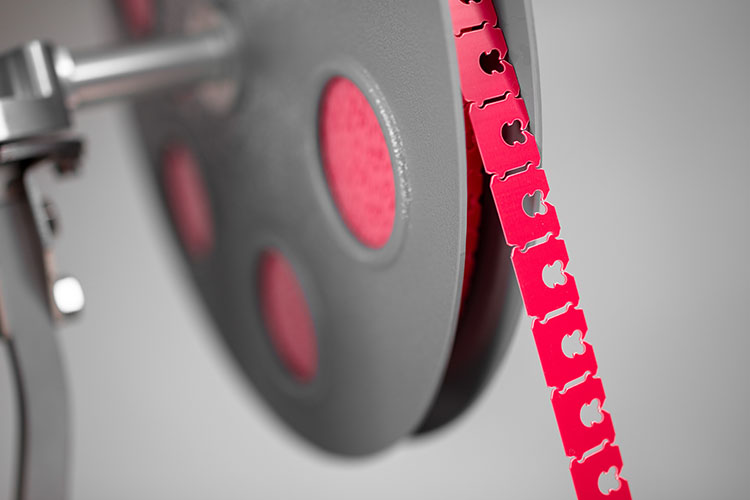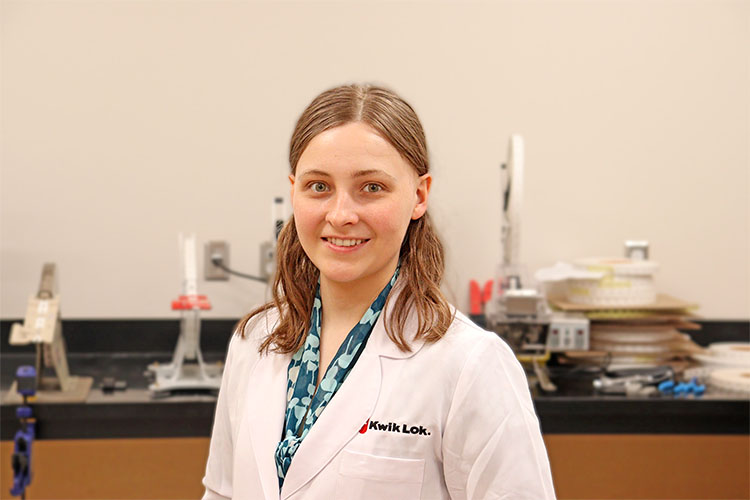
Widely different concepts, approaches and methods lead to advancing sustainability throughout a company’s operations. For Kwik Lok, sustainable materials used in packaging closures are the immediately visible result of this mindset. And, this priority also influences the process.
Viktoria Pakhnyuk, PhD, Sustainable Product Development Manager, Kwik Lok, contributed to this article
Just before the end of 2022, Kwik Lok launched Fibre-Lok in the US, following a successful reception from the Australian market of a recyclable lok made of 100% post-consumer recycled fibers. Kwik Lok also released a certified home-compostable version of the locks (branded as ‘loks’) in the European market, made of responsibly sourced natural cellulose wood and cotton fibers. Each product provides the same functionality and durability that the plastic version brings. The Fibre-Lok joins a sustainable family of products including the Eco-Lok, a closure launched in 2019, formulated with a plant-based biopolymer – NuPlastiQ. Producing this material lowers the use of traditional plastics; it is reusable and metal detector-compatible.
It is a growing family of products, with Kwik Lok focusing its efforts on “transitioning the industry toward a sustainable future through innovation,” as Don Carrell, Kwik Lok’s CEO, emphasized at the launch of the Fibre-Lok. To support the R&D in this direction, Viktoria Pakhnyuk, Sustainable Product Development Manager, lends her expertise in material science. She leads multiple projects in the research and development of environmentally conscious, bio-based bag closures.
From concept to process
With various kinds of input coming in from all departments – including sales, engineering and marketing, she oversees projects from the concept stage through developments into new products. With Kwik Lok’s growing material options, she leads in establishing a process with specific milestones by involving the right people in each phase. Her scientific background is especially important in the testing and development stages. The goal seems straightforward: making (more) sustainable loks; but, variables leading to their development need to be carefully balanced. The answers to preliminary questions refine the concept by defining a target market’s demands while understanding available material options. Preferences and regulations are part of the equation. For example, France is familiar with and has readily available composting options, which would make a compostable product suitable. Alternatively, other markets will prefer certain types of plastics for which they have recycling capabilities. The UK, for example, has defined different types of plastics using a color-coded system. Product costs will also be influenced by the availability of the materials and their composition.
Technical aspects must also be reviewed: How can other materials be formulated to behave like the original plastic? How well are new materials processed on existing specialized equipment? The company follows steps deriving from these questions.
Forming partnerships is key to developing options with suitable material properties by combining scientific and industrial expertise. Material grades and blends are designed and analyzed for the bag closing application.
Testing includes assessing the materials’ mechanical and melt properties, for example. The right balance needs to be found so that the loks can be easily separated from each other on the strip without breaking individual loks.
Specific utilization requirements are taken into consideration in the development process, such as the temperature and humidity of application and storage conditions.
Kwik Lok also needs to address the challenge of making the new materials work with the company’s own established manufacturing processes. Supply volumes are evaluated to ensure availability for customer projections. Once lab tests have been carried out successfully, a larger sample goes through production trials replicating the manufacturing process normally employed, followed by further optimization. Since the company provides not only the bag closures, but also the machines that attach them to their packaging, it aims to release new products that will not require replacing bag closing machines already in the field. “Being sustainable does not have to mean taking big leaps,” Pakhnyuk highlights.
What is sustainability? Material science answers
Working to improve the sustainability of packaging solutions and all related processes for day-to-day operations started at Kwik Lok by clearly categorizing the concept into three separate ‘boxes’:
- Feedstock – the material source and composition (e.g. petroleum-based, bio-based, recycled content)
- Processing – the inputs and outputs of raw material production and product manufacturing (energy usage, water needs, carbon footprint, etc.)
- End-of-life – the product’s fate after serving its intended purpose (landfill/incineration, recycling, or compost)

Bio-based materials are an interesting option for new product development in the future, since their costs are also likely to decrease as they become more widely available and regulations support their use. “The challenge is how to make a bio-based material act like it isn’t bio-based,” Pakhnyuk explains. There are different approaches to incorporating bio-based materials to offset the use of fossil-based materials. One approach is to introduce a bio-based additive to form a plastic composite, as Kwik Lok has done with NuPlastiq in the Eco-Lok.
Another approach is to use plastic created by an alternative chemical process while replicating the same final chemical structure – instead of coming from crude oil, it may be made from a renewable bio source such as agricultural by-products. The third option is to replace traditional plastics with compostable plastic, which are often bio-based.
“You can prioritize one box over another or try to target all three. This is why it is difficult to rank what materials are ‘better’ than others – the answers will vary according to the selected priorities,” she explains. Lifecycle analyses are instrumental in providing more insights that can give direction for the specific sustainability path chosen. By inputting factors such as material type, processing steps and geography, a lifecycle analysis will quantitatively compare the environmental impacts of different packaging options.
Making sure the appropriate waste infrastructure is in place is one determining factor to ensure that a circular economy is supported at a lok’s end-of-life. The type of bag for which the closure is used also plays a role – if it’s plastic, it makes sense for to lok to be made of a similar material for recycling, for instance, while a paper bag would better match a fiber-based lok.
Sustainability education – a learning process
Once a product is developed, it is important to communicate a product’s qualities by using data to back up claims to prevent greenwashing. The gold standard is having it reviewed by a third party, Kwik Lok adds, which can earn the product useful certifications. Therefore, product claims gain more weight and harder to challenge. The home compostability of the FibreLok, for example, has been tested and certified according to rigorous lab standards.
Kwik Lok also makes sure to pay attention to terminology in the sustainability space as it is changing and being refined to provide the most clear messaging.
In addition to R&D and sustainability education, consumer pressure for certain solutions should not be overlooked – usually, this takes the form of the demand to remove plastic, even when doing so may actually add to the company’s carbon footprint or not be the optimum choice for the product’s end-of-life fate, for instance. Process transparency to help educate consumers will go a long way, but, it requires dedicated efforts.
Accessible labeling practices can easily help provide consumers with more meaningful information.
Increasing sustainability is more of a winding road than a traveled avenue: “Plastics are going to be around for a while as a solution that makes sense for its qualities. Many times, there isn’t a good substitute, either. There is definitely an opportunity for innovation here; the challenge will be making it work with existing systems,” Kwik Lok’s research specialist anticipates. Standardized transparency is bound to play an instrumental role in sustainability advances, recycling practices, processes and awareness, and new product innovation, in the long run.
Photos: Kwik Lok


